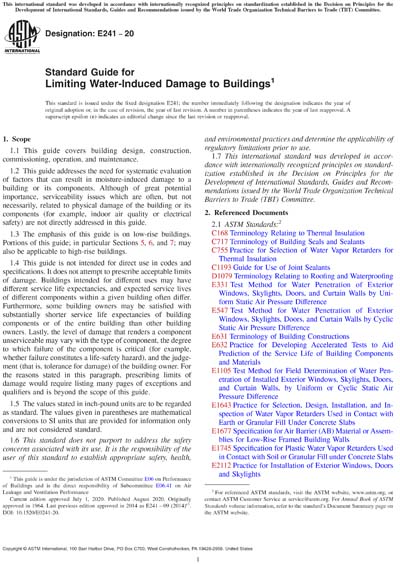Most recent
ASTM E241-20
Standard Guide for Limiting Water-Induced Damage to Buildings
1.1 This guide covers building design, construction, commissioning, operation, and maintenance.
1.2 This guide addresses the need for systematic evaluation of factors that can result in moisture-induced damage to a building or its components. Although of great potential importance, serviceability issues which are often, but not necessarily, related to physical damage of the building or its components (for example, indoor air quality or electrical safety) are not directly addressed in this guide.
1.3 The emphasis of this guide is on low-rise buildings. Portions of this guide; in particular Sections 5, 6, and 7; may also be applicable to high-rise buildings.
1.4 This guide is not intended for direct use in codes and specifications. It does not attempt to prescribe acceptable limits of damage. Buildings intended for different uses may have different service life expectancies, and expected service lives of different components within a given building often differ. Furthermore, some building owners may be satisfied with substantially shorter service life expectancies of building components or of the entire building than other building owners. Lastly, the level of damage that renders a component unserviceable may vary with the type of component, the degree to which failure of the component is critical (for example, whether failure constitutes a life-safety hazard), and the judgement (that is, tolerance for damage) of the building owner. For the reasons stated in this paragraph, prescribing limits of damage would require listing many pages of exceptions and qualifiers and is beyond the scope of this guide.
1.5 The values stated in inch-pound units are to be regarded as standard. The values given in parentheses are mathematical conversions to SI units that are provided for information only and are not considered standard.
1.6 This standard does not purport to address the safety concerns associated with its use. It is the responsibility of the user of this standard to establish appropriate safety, health, and environmental practices and determine the applicability of regulatory limitations prior to use.
1.7 This international standard was developed in accordance with internationally recognized principles on standardization established in the Decision on Principles for the Development of International Standards, Guides and Recommendations issued by the World Trade Organization Technical Barriers to Trade (TBT) Committee.
ASTM International [astm]

